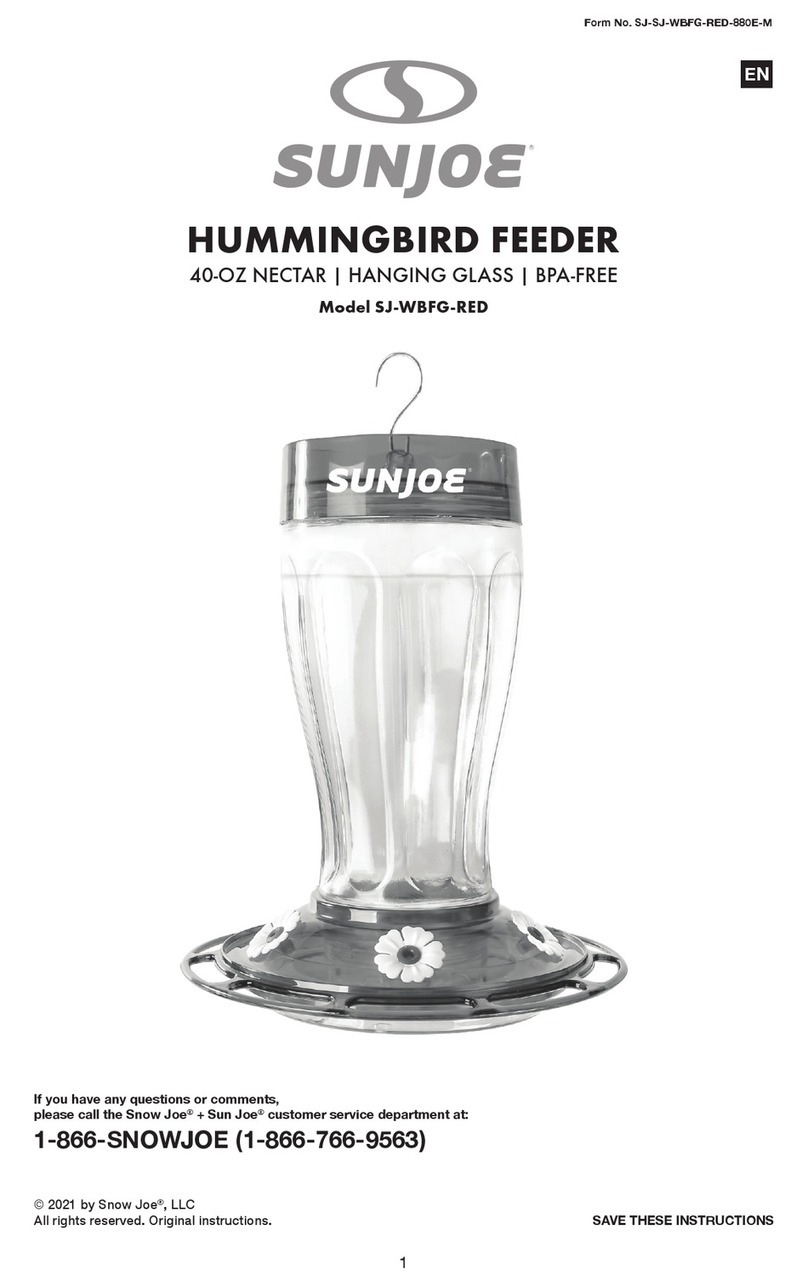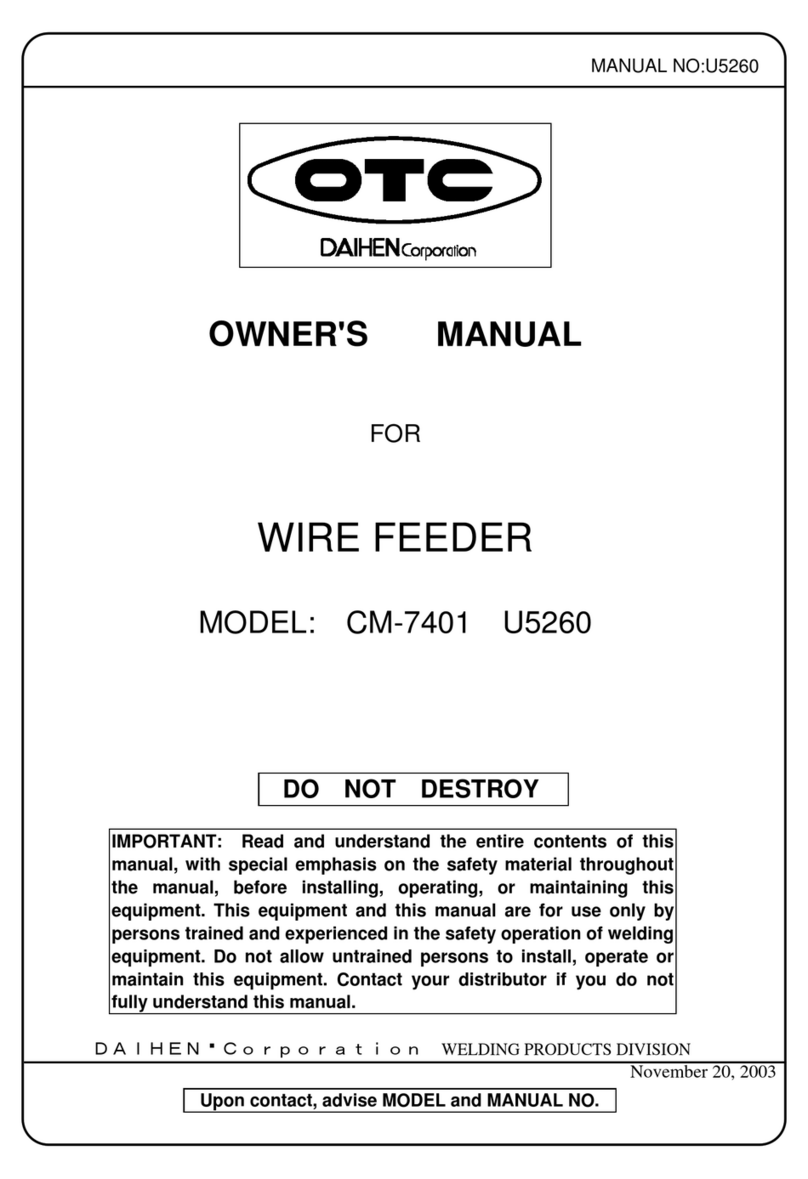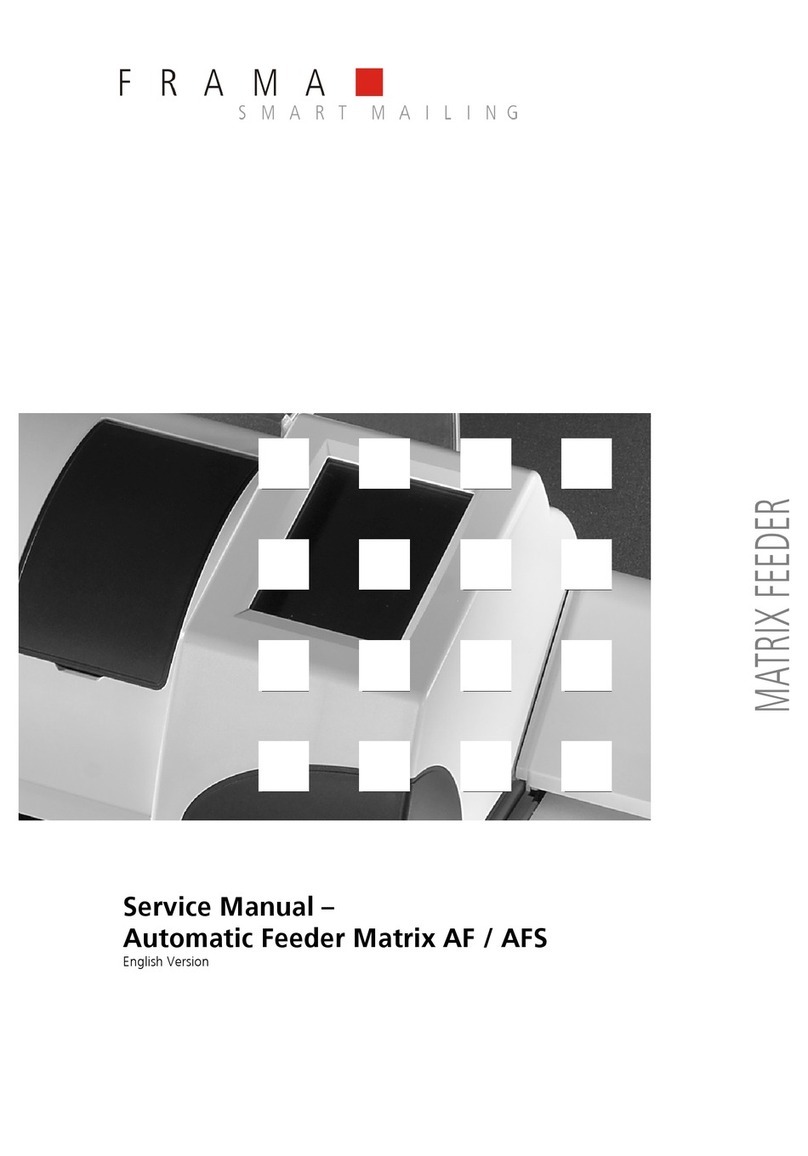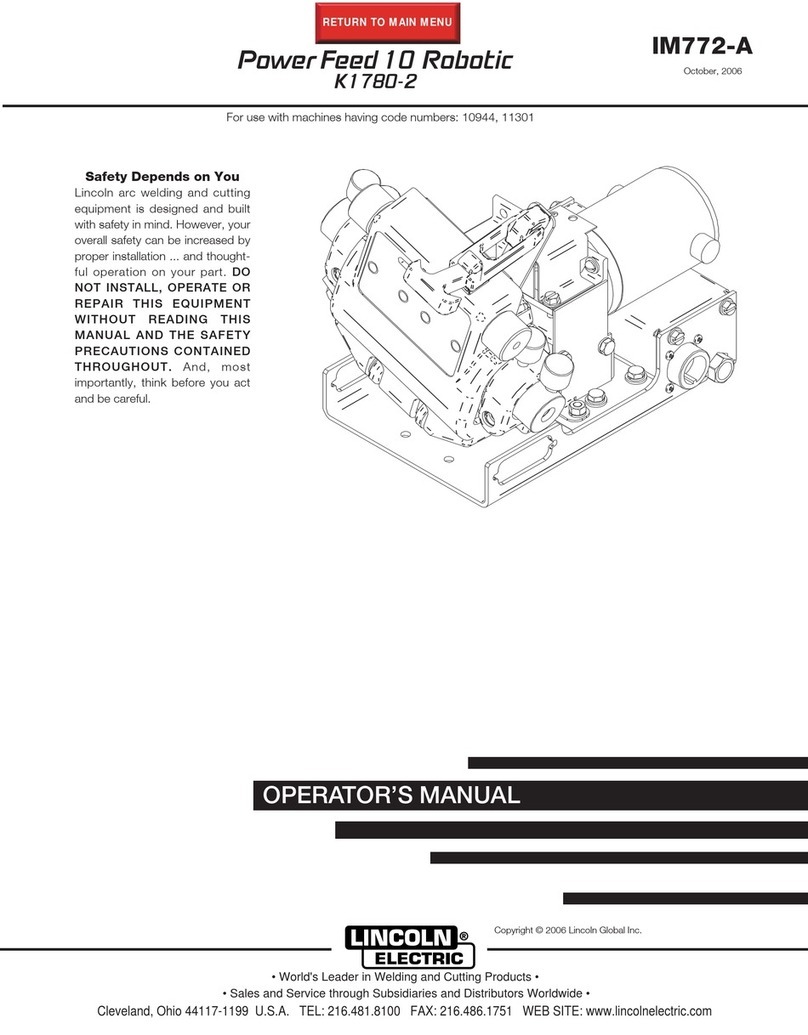Barry-Wehmiller Streamfeeder Value Series User manual

Manual
Value Series V-710IJ

Part Number: 00900367
© 2009 Thiele Technologies, Inc. - Streamfeeder. All rights reserved.
No part of this publication may be reproduced, photocopied, stored on
a retrieval system, or transmitted without the express written consent of
Thiele Technologies, Inc. - Streamfeeder.
Thiele Technologies, Inc. - Streamfeeder
103 Osborne Road
Minneapolis, MN 55432-3120 USA
Tel:763.502.0000
Fax:763.502.0100
e-Mail: service@streamfeeder.com
Web: www.streamfeeder.com
Printed in the USA.

i
Value SerieS V-710iJ Manual
Contents
Safety Information ........................................................ii
Specications ..............................................................iv
Section 1: About the Machine .......................................................1
Section2: InstallingtheMachine ..................................................5
Section3: PreparingforOperation ............................................. 11
Section4: HowtoOperate ...........................................................19
Section5: Troubleshooting .........................................................23
Section6: InspectionandCare ...................................................25
Section7: MechanicalComponents ...........................................31
Section8: ElectricalComponents...............................................46

ii Value SerieS V-710iJ Manual
Message
Conventions
DANGER signies an action or specic equipment area that can result
in serious injury or death if proper precautions are not taken.
WARNING signies an action or specic equipment area that can
result in personal injury if proper precautions are not taken.
CAUTION signies an action or specic equipment area that can
result in equipment damage if proper precautions are not taken.
ELECTRICAL DANGER signies an action or specic equipment
area that can result in personal injury or death from an electrical haz-
ard if proper precautions are not taken.
TIP signies information that is provided to help minimize problems
in the installation or operation of the feeder.
NOTE provides useful additional information that the installer or
operator should be aware of to perform a certain task.
CHECK signies an action that should be reviewed by the operator
before proceeding.
IMPORTANT alerts the installer or operator to actions that can poten-
tially lead to problems or equipment damage if instructions are not
followed properly.
WARNING LABELS afxed to this product signify an action or spe-
cic equipment area that can result in serious injury or death if proper
precautions are not taken.
Before You Begin

iii
Value SerieS V-710iJ Manual
Message
Conventions
Before You Begin
Avoid injury. Do not reach around guards.
Hazardous voltage. Contact will cause electric shock or burn. Turn off
and lock out power before servicing.
Moving parts can crush and cut. Keep guards in place. Lock out power
before servicing.
Pinch point. Keep hands and ngers clear.
Moving parts can crush and cut. Keep guards in place. Lock out power
before servicing.

iv Value SerieS V-710iJ Manual
Maximum Product Size: ........................ 12 W x 12 L in (305 x 305 mm)*
Minimum Product Size: ........................ 3.75 W x 3.75 L in (95 x 95 mm)
Optional: ................................................... 2.5 W x 2.5 L in (63 x 63 mm)
Min/Max Product Thickness: ....................... .003-.75 in (.076-19.1 mm)
Belt Speed: ................................................. 5700 in/min (144780 mm/min)
Electrical Requirements: ................................... 115/230vac, 50/60Hz, 3A
Weight: ............................................................................... 41 lbs. (18.6kg)
*Optional product size available
speCifiCations

1
Value SerieS V-710iJ Manual
1About the Machine
The V-710IJ Universal Friction Feeder is designed for reliability,
exibility, and ease of use with a variety of vacuum and non-vacuum
bases.
All parts required for setup, loading, feeding, and easy operator con-
trol are combined into one compact unit.
Review the main assemblies in Figure 1-1 to become familiar with
names and locations of feeder parts and adjustments. This will help to
prepare you for initial setup. Descriptions are found in Table 1-1.
Review the control panel components in Figure 1-2 to become fa-
miliar with names and locations of specic connectors, switches, and
controls. This will help to prepare you for installation and operation.
Descriptions are found in Table 1-2.
Figure 1-1. Main Assemblies of the V-710IJ Universal Friction Feeder
Features
Main Assemblies
•ACPowerCord
•SideGuides
•ExternalRunInputCord(Optional)
LoosePartsSupplied:
GateAssemblyand
Adjustment
TableTop
FeedBelts
BackWedgeandAdjustments
Hold-Down
Assembly
Discharge
Belts RaisedFeedBelts
Adjustment
SideGuides

2Value SerieS V-710iJ Manual
Feature Description
Gateassemblyandadjustment Mounted on a gate bracket assembly above the feed belts, this device
provides a curvature to help preshingle stacked material. When properly
adjusted, a clearance is created to help singulate and feed material.
Tabletop Used to support the back wedge.
Raisedfeedbeltsadjustment Located on each side of the feeder, these adjustment knobs allow you to
raise the rear feed belts above the table top to achieve optimum contact
with material.
Sideguideadjustments Dual-knob design allows you to move side guides together or apart for
different size material. Can be positioned equally or offset. (Note: Single-
knob design also available.)
Dischargesafetyshield Provides residual risk protection to operator when feeder is running.
Backwedgeandadjustments Lifts the material to keep it off the table top, reduces excessive contact
with the feed belts, and helps push the material against the curvature
of the gate assembly. To achieve proper lift, adjustment wing-nuts and
locking levers allow you to slide the wedge to various positions and
angles.
Feedbelts Provides the friction and motion necessary to pull individual material from
the bottom of the stack and through the gate assembly area.
Dischargebelts Combined with the top roller hold-down assembly, provides the friction and
motion necessary to transport material away from the gate assembly area.
Hold-downassembly A series of small rollers mounted on movable brackets help to gently hold
material down on the discharge belts as material exits the gate assembly
area. These brackets and rollers are part of the gate assembly and are
removed when the gate assembly is removed.
Controlpanelcomponents For descriptions, see Figure 1-2A and 1-2B, and Table 1-2.
ACpowercord,8ft.(2.44m) IEC320 removal three-prong. Shipped loose.
Externalruninput(optional) This two-wire cable allows the feeder to be turned On or Off with the host
base.
ProductDescription Section1
Table1-1. MainAssembliesFeatureDescriptions

3
Value SerieS V-710iJ Manual
Figure 1-2A. Control Panel Components (Left and Right Side Views)
ControlPanelComponents
Figure 1-2B. Control Panel Components (End View)

4Value SerieS V-710iJ Manual
Feature Description
Externalruninputconnector This 4-pin connector (labeled ExternalRunInput) is used to carry start/
stop signals from a vacuum or non-vacuum base to the feeder.
PowerOn/Off Toggles AC power On or Off.
Fuseholder Contains two replaceable 5-Amp, 5x20 mm time delay fuses.
IMPORTANT: Always make sure power module is replaced exactly as
removed so that “115” is always visible on 115V models and "230" is
always visible on 230V models. Failure to follow this caution can result in
damaged electrical parts.
ACpowercordsetconnector Cordset plugs into this IEC320 connector to provide feeder with power
from a grounded and fused outlet.
Modeswitch(optional) Note: Included with optional external run input only. This slide switch
(labeled Continuous/ExternalRun) allows you to use the feeder “stand-
alone” or with the optional external run input interface.
Variablespeedcontrol This dial switch (labeled Speed) allows the feeder speed to be
synchronized with a vacuum or non-vacuum base. Turning counter-
clockwise decreases speed; clockwise increases speed. Note: Feeder
motor stops if turned completely counter-clockwise.
Rundelay Used to delay (or synchronize) feeder startup with base startup. Range is
adjustable from 0 to 12 seconds.
Table1-2. ControlPanelFeatureDescriptions
(optional)

5
Value SerieS V-710iJ Manual
2 InstallingtheMachine
!
!
!
When performing initial installation, always
make sure you turn Off the main power
switch and disconnect all equipment from the
electrical power source. Failure to do so can
expose you to a potential startup and moving
parts which can cause serious injury.
Do not attempt feeder installation while
the feeder and machine of application are
running. Failure to do so can expose you to
moving parts which can cause serious injury.
Do not wear loose clothing when operating the
feeder.
Avoid turning on the feeder or making initial
adjustments until all parts are secured. Failure
to do so can cause damage to equipment.
This section provides information on installing the V-710IJ Universal
Friction Feeder onto a vacuum or non-vacuum transport base.
Information for a particular application typically includes procedures
for basic parts removal, feeder mounting and alignment, and cable
connections for power and control interface. Information that relates
to specic adjustments you must make to feeder prior to startup and
operation is found in Section 3, “Preparing for Operation.”
VacuumBase
Installation
Installation of the V-710IJ Universal Friction Feeder onto various
types of vacuum and non-vacuum bases is a relatively simple proce-
dure. Several minor modications to the vacuum base are required
prior to mounting, wiring, and aligning the feeder.
To install the feeder onto a vacuum base, perform the following steps:
1: Repositioning front side guides
2: Removing back jogging plate/back hopper guide
3: Raising hopping rollers
4: Disabling the shuttle
5: Initial positioning of feeder
6: Providing AC power to feeder
7: Connecting external run input
8: Checking material discharge from feeder

6Value SerieS V-710iJ Manual
1. Loosen locking knobs at both side guides (Figure 2-1).
2. Slide each side guide to the outermost position. Do not lock in
place.
1. Loosen each of the setscrews at the two shaft housing assem-
blies A and B (Figure 2-2).
2. Slide shaft end closest to the vacuum base gate out of housing
A (with jogging plate/hopper guides still attached). Slide shaft
back far enough on housing B to allow removal of jogging
plate/hopper guides.
3. Loosen locking knob and slide jogging plate/back hopper
guide off of shaft and away from the surface of the vacuum
base.
4. Return shaft end to housing B. Lock setscrews in both housing
assemblies.
STEP2:
RemovingBackJogging
Plate/BackHopperGuide
STEP1:
RepositioningFront
SideGuides
Figure 2-1. Front Side Guides Being Repositioned
Figure 2-2. Back Jogging Plate/Back Hopper Guide Removal
Front side
guides
Locking
knob
A
BLocking knob

7
Value SerieS V-710iJ Manual
STEP3:
RaisingHoppingRollers
If additional control of material is required
during feeding, you may choose to keep the base’s
hopping roller assembly in the down (or normal)
position.
NO TE
Figure 2-3. Using the Adjustments to Raise Hopping Rollers
STEP4:
DisablingtheShuttle
To prevent any accidental startup of shuttle
motor and to eliminate the hazard of moving
parts, you can prevent accidental startup by
either disconnecting vacuum base from AC
power at the outlet, or you can remove the
internal AC power fuse (located behind the
access door of the vacuum base).
!
!
Figure 2-4. Disabling the Shuttle from Inside the Access Panel
Vertical adjustment
lever
Gate adjustment
knob
Reciprocating
arm
Hex-head
rod end
bearing bolt
Reciprocating
block
1. Locate the gate adjustment knobs (Figure 2-3) and turn com-
pletely in a clockwise direction to raise hopping rollers.
2. Then, locate the vertical adjustment lever on the hopping roll-
ers assembly and push down all the way. This will raise the
feed rollers to highest vertical position possible, thus making
for maximum clearance.
1. Remove side access panel from vacuum base enclosure.
2. Locate the reciprocating arm and reciprocating block directly
beneath the underside of shuttle (Figure 2-4).
3. Using a box wrench, remove the hex-head rod end bearing
bolt holding the reciprocating arm to the reciprocating block.
4. Once the bearing bolt is removed, the reciprocating arm is ef-
fectively disconnected. As the shaft is connected to the shuttle
base plate on the other end, simply allow the shaft to hang
in-position, with no further disassembly.
5. Make sure the base plate of shuttle is all the way forward
(toward the vacuum base gate).

8Value SerieS V-710iJ Manual
1. Lift the feeder onto the top plate of the vacuum base and slide
forward toward the vacuum base gate.
2. Center the feeder between the two side guides as you posi-
tion the feeder fully forward. To verify centering, sight down
the center of the feeder gate, making sure it is in-line with the
vacuum base gate (Figure 2-5).
3. Trap the feeder in-between the vacuum base side guides by
sliding each in toward the side plates of the feeder until they
gently touch. Tighten side guide knobs to secure in position.
1. Connect IEC320 end of power cord to the feeder (at the power
inlet module).
2. Connect three-prong end to nearest AC voltage power source.
STEP5:
InitialPositioning
ofFeeder
Figure 2-5. Positioning the Feeder on the Vacuum Base
STEP6:
ProvidingACPower
toFeeder
Please verify that the voltage shown at the power
inlet module matches the incoming voltage from
the power source.
In order to comply with EN 6100-4-5, the AC
power line must be protected with a surge
suppressor.
Center
IMPOR TANT

9
Value SerieS V-710iJ Manual
STEP7:
Connecting
ExternalRunInput
This procedure should be performed only by a
qualied technician.
IMPOR TANT
Figure 2-6. Gaining Access to Vacuum Base Start/Stop Circuit
STEP8:
CheckingMaterial
DischargefromFeeder
Make sure rollers on vacuum base are raised in
the highest vertical position so that it does not
interfere with the material.
IMPOR TANT
Access door
Using the two-wire interface cable supplied for vacuum base applica-
tions:
1. At the feeder, connect external run input cable to feeder using
the two-pin threaded connector on the control panel.
2. At the vacuum base, open access door at end of the lower
enclosure to locate start/stop control circuit (Figure 2-6).
3. Route external run input cable from the feeder to this area.
4. Determine the exact run input voltage required by checking
the label on the run input cable.
5. Interface the two bare wire leads at the opposite end of the
interface cable to the vacuum base start/stop circuit. This
involves splicing the black wire and red (AC, DC or dry con-
tact) wire to the start/stop circuit.
As material leaves the feeder gate cylinder, the trailing edge must be
under the hold-down as the leading edge is entering the vacuum base
transfer section. In otherwords, there must be a good transfer of mate-
rial from the feeder hold-down to the vacuum base transfer section.
To verify:
1. Slide feeder back far enough to clear the vacuum base side
guides. If necessary, loosen the knobs on both side guides and
pull to the outside slightly to allow movement of the feeder.
2. Insert a piece of material under the hold-down in such a way
that approximately 2/3 of the leading edge is extending out
beyond the feeder (Figure 2-7).
3. Slide feeder back into position, making sure it is again cen-
tered between the side guides. As you do so, also make sure
that the leading edge of the material moves into the transfer
section of the vacuum base unobstructed.

10 Value SerieS V-710iJ Manual
Figure 2-7. Checking for Proper Material Discharge from Feeder to Vacuum Base
4. Check to make sure the material is still under the hold-down
roller bearings and also resting on the vacuum base transfer
section.
5. Trap the feeder in-between the side guides until they gently
touch. Tighten side guide knobs.
STEP8:
CheckingMaterial
DischargefromFeeder
(continued)
Leading edge
should be 2/3into
transfer section

11
Value SerieS V-710iJ Manual
3 PreparingforOperation
!
!
!
When performing initial feeder adjustments
prior to operation, always make sure you turn
Off the main power switch and disconnect all
equipment from the electrical power source.
Failure to do so can expose you to a potential
startup and moving parts which can cause
serious injury.
Do not attempt to make any adjustments while
the feeder and machine of application are
running. Failure to do so can expose you to
moving parts which can cause serious injury.
Do not wear loose clothing when operating the
feeder.
Avoid making adjustments with loose or
unsecured parts. This can potentially damage
parts.
Once the Streamfeeder V-710IJ Universal Friction Feeder is installed
on your host system, you are then ready to prepare the machine for
operation. To do so, you must perform several adjustments with the
material you are going to be feeding. And, you must do a test run with
this material to verify that it is set correctly before you begin cycling
the feeder. You will have to perform this procedure for material you
plan to feed.
The adjustments you must make (in order) are as follows:
1: Gate assembly adjustment
2: Side guides setting
3: Back wedge adjustment
4: Verifying proper installation
Leading edge
should be 2/3into
transfer section

12 Value SerieS V-710iJ Manual
!
Excessive lowering of the gate assembly can
damage product or lead to premature wear of the
O-rings or feed belts.
TIP
A wider gap between product and belt provides
the highest tolerance for curled and bent edges.
L
O
W
E
R
STEP1:
GateAssembly
Adjustment
Figure 3-2. Using One-Piece Thickness of Product to Set Gap Figure 3-3. Adjusting Gate Assembly for Correct Gap
Figure 3-1. Lifting Gate Assembly Upward to Insert Product
NO TE
Feeding problems will occur with either too
much material in the hopper, or too large a gap
between the gate assembly and the material.
Procedure
To adjust the gate assembly for proper gap:
1. Slide a single sheet of test product under the gate assembly.
It may be necessary to pull up on the adjustment knob to allow
the piece to be inserted.
2. Test the piece for clearance. Grasp the product with two hands
and slide it front-to-back under the gate assembly. A proper
adjustment allows a slight amount of drag on the top of the
piece.
3. Adjust the knob on the gate assembly until the piece has the
desired drag. Turn the knob clockwise to increase clearance or
counterclockwise to decrease clearance.
4. Repeat the drag tests and adjust as needed to achieve accept-
able clearance.
If material does not move freely, then the gate
assembly is too tight. This can lead to premature
wear of the O-rings or feed belts.

13
Value SerieS V-710iJ Manual
STEP1:
GateAssembly
Adjustment
(continued)
To adjust the gate for effective material skew control, follow these
steps:
1. Repeat drag test detailed on page 12.
2. Test the piece for uneven side-to-side drag. Grasp with two
hands and slide it front-to-back under the gate assembly. A
proper adjustment allows for equal drag on the left and right
sides of the piece of material.
3. To compensate for greater drag on one side of the material,
turn the opposite adjustment roller counterclockwise 1/8 turn.
Next, turn the other adjustment roller clockwise 1/8 turn.
4. Repeat drag tests and adjust as needed until equal drag is
achieved. You may need to repeat this procedure after observ-
ing the feeder cycling (refer to Section 4, “How to Operate”).
NO TE
When feeding product with varying thickness
throughout, it may be necessary to turn
both adjustment rollers 1-2 full turns
counterclockwise to compensate for the
differential thickness. This procedure allows the
gate horizon to “oat.”
IMPOR TANT
The adjustment knob set screws are pre-set at the
factory to lock the knob to the threaded rod. DO
NOT OVER-TIGHTEN! Over-tightening the set
screws may damage the components.
Figure 3-4. Horizon Adjustment Mechanism (shown on Advancing O-Ring Gate)

14 Value SerieS V-710iJ Manual
ChangingFrom
FactorySet
High-Tensionto
Low-Tension
IMPOR TANT
When changing from a low-tension to high-
tension setting, you may have to adjust the
stack height downward to prevent feeding
problems.
!
Excessive lowering of the gate assembly can
damage material and/or lead to premature
wear of the O-rings or feed belts.
NO TE
Certain types of single-sheet material may
require even more tension than the high-
tension setting can provide. To increase
tension even further, place a washer between
the cylinder and spring.
Washer
C
A B
Figure 3-5. Adjusting Gate Assembly for Low-Tension
Procedure
Certain types of material may demand that you change the gate
assembly from a high-tension setting to a low-tension setting (for
example, irregular shaped material).
To change the spring from a high to a low tension, follow these steps:
1. Remove the gate assembly from gate bracket assembly. To
do so, pull cylinder down with one hand, lift up on knob
with other, and tip at slight angle to remove.
2. Remove the adjustment knob by turning counter-clockwise.
Then lift the cylinder off of top of spring.
3. Turn the cylinder around so that the cylinder collar faces
up. Then place the cylinder on top of the spring.
4. Replace the adjustment knob (make about 8 revolutions of
the knob before reinstalling gate assembly on gate plate).
This manual suits for next models
1
Table of contents
Other Barry-Wehmiller Wire Feeder manuals
Popular Wire Feeder manuals by other brands

ESAB
ESAB Origo Feed 354 P3 instruction manual
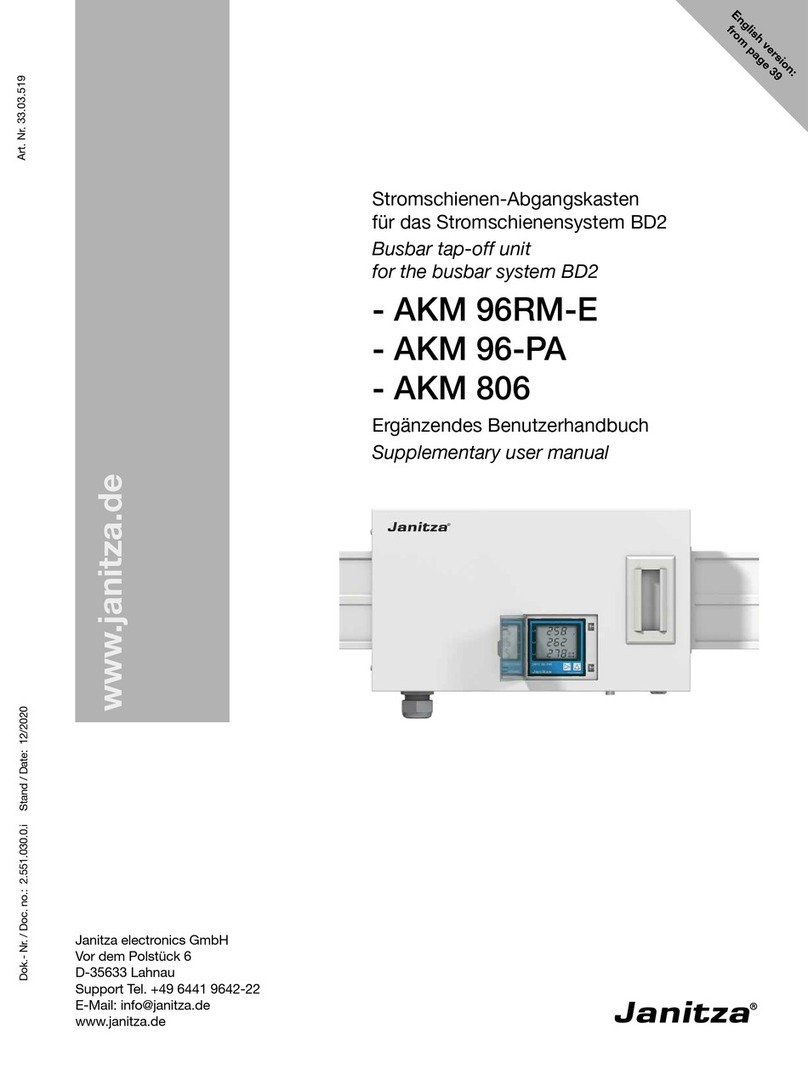
janitza
janitza AKM 96RM-E user manual

Afag
Afag HLF12-P Operating and installation instructions

IPG Photonics
IPG Photonics LightWELD Setup guide
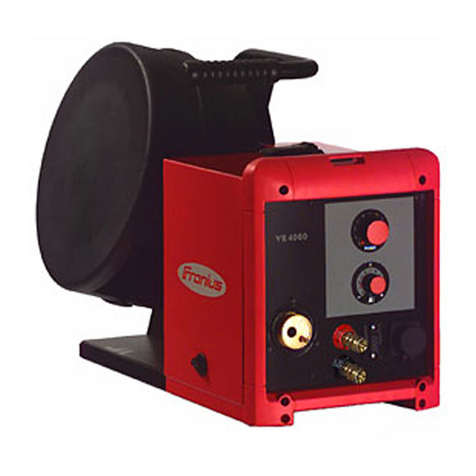
FRONIUS
FRONIUS VR 4000 Operating instructions/spare parts list
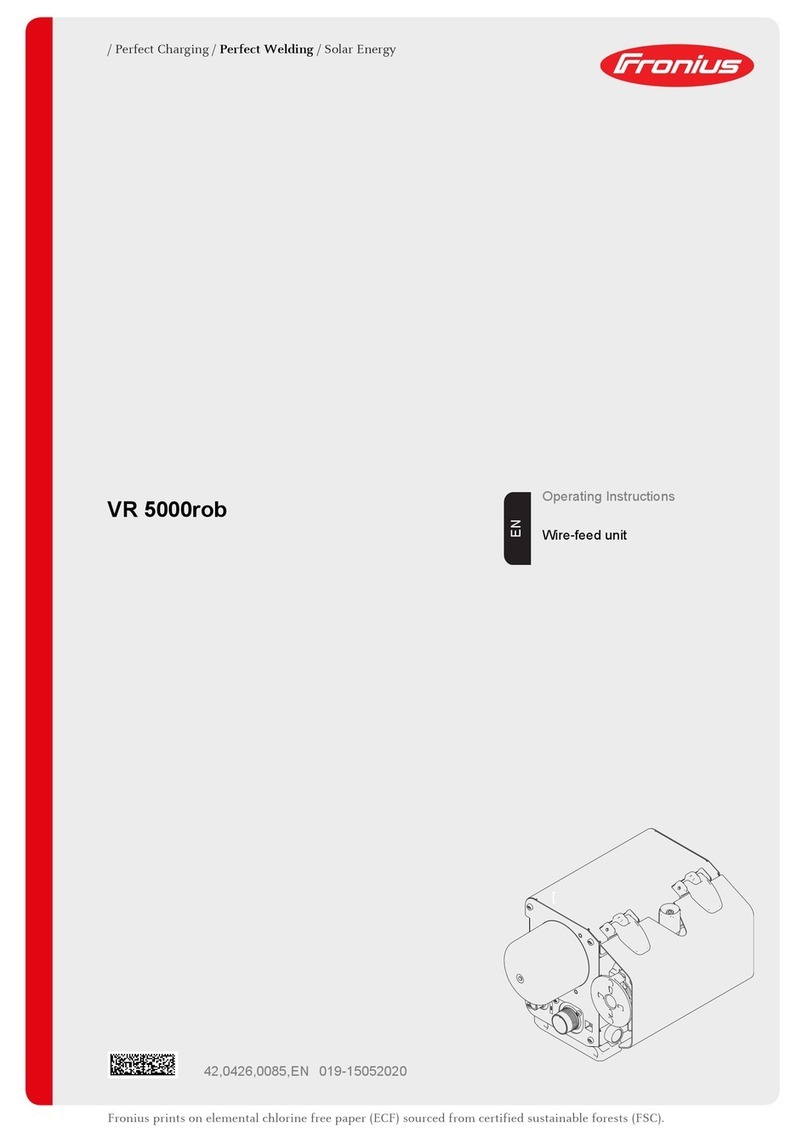
FRONIUS
FRONIUS VR 5000rob operating instructions

